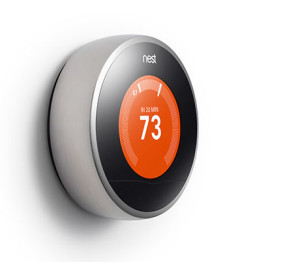While you are waiting in the terminal with your flip-flops on, you suddenly remember you didn’t change the thermostat. Now while you are on vacation, your home will be heating and cooling itself as if the whole family is there to enjoy it. Sadly, only the houseplants will feel the cool air conditioning.
 The Nest, a popular Smart Thermostat touted as “the iPod of thermostats”
The Nest, a popular Smart Thermostat touted as “the iPod of thermostats”
This scenario plays out differently if you invest in a smart thermostat. With a smart thermostat, your paradise daydreams are only interrupted for a few minutes. Once you realize your thermostat mistake, you can simply pull up your thermostat on your smartphone and switch the device to vacation mode. After it’s switched, you can go back to vacation without any worries. All because of a smart thermostat, you have peace of mind and a more energy-efficient home.
A smart thermostat differs from a regular or programmable thermostat. It learns your routine, adjusts based on ambient conditions, offers remote access and shows energy consumption in real-time. In a year, you can save $180 in heating and cooling costs by installing a smart thermostat. [1]
It’s called a smart thermostat because it does the calculating for you. Instead of adjusting the thermostat manually or setting a weekly schedule on a programmable thermostat, the smart thermostat learns your habits in a week and does all the adjusting for you. Because the first week is the most important, keep in mind the temperature changes you are making. You want the thermostat to remember you come home late on Thursday evening because your child has soccer practice or that you leave early for work on Tuesday mornings. If you do a lot of excessive yo-yoing or if other family members adjust the thermostat, remind yourself and them to make long-term, energy saving changes. You can always go in and adjust the temperature though if anything gets off track that first week.
Along with its habit sensors, different devices detect ambient conditions such as humidity and take these factors into account. While it makes the temperature changes, it uses complex algorithms to make the changes efficiently.
Because smart thermostats are connected to Wi-fi, you can install apps on your smartphone to control the thermostat remotely. Companies offer Android and iPhone apps. So no matter the location, you have your home energy at your fingertips. You can change the settings to notify it that you are staying late at the office or forgot to change it to vacation mode. The remote access also allows you to see the real-time energy consumption of your home. The device itself will also let you see this data, and many give alerts and reminds for things such as filter changes.
While all these features offer convenience, they do come at a price. Upfront, you can spend upwards of $300 plus installation. For installation, you can work with the company you purchase the smart thermostat from or contact a local heating and air conditioning technician for assistance. According to the U.S. Department of Labor, installers cost $21 per hour on average. [2] But you can install the device yourself, but it can be tricky though it does give you additional financial savings right away. Once everything is set up, whether you or someone else installed it, your smart thermostat starts tracking your heating and cooling habits.
A few different brands have been on the market for a while and have worked out many of the kinks. Nest starts at $249 and features settings that coordinate with auxiliary heat. ecobee starts at $400 with installation and offers a web portal to monitor your home energy. Honeywell starts at $249 and provides alerts on your furnace, filters and the weather.
Once you have your smart thermostat installed, you set it and then let it better your home energy efficiency for you. But if you need it, remember, it’s only an app away.
Author: Brenna Malmberg [1] Energy Stat: Heating and Cooling Efficiency [2] U.S. Labor StatisticsTags
Subscribe to NV Roofing's Blog



